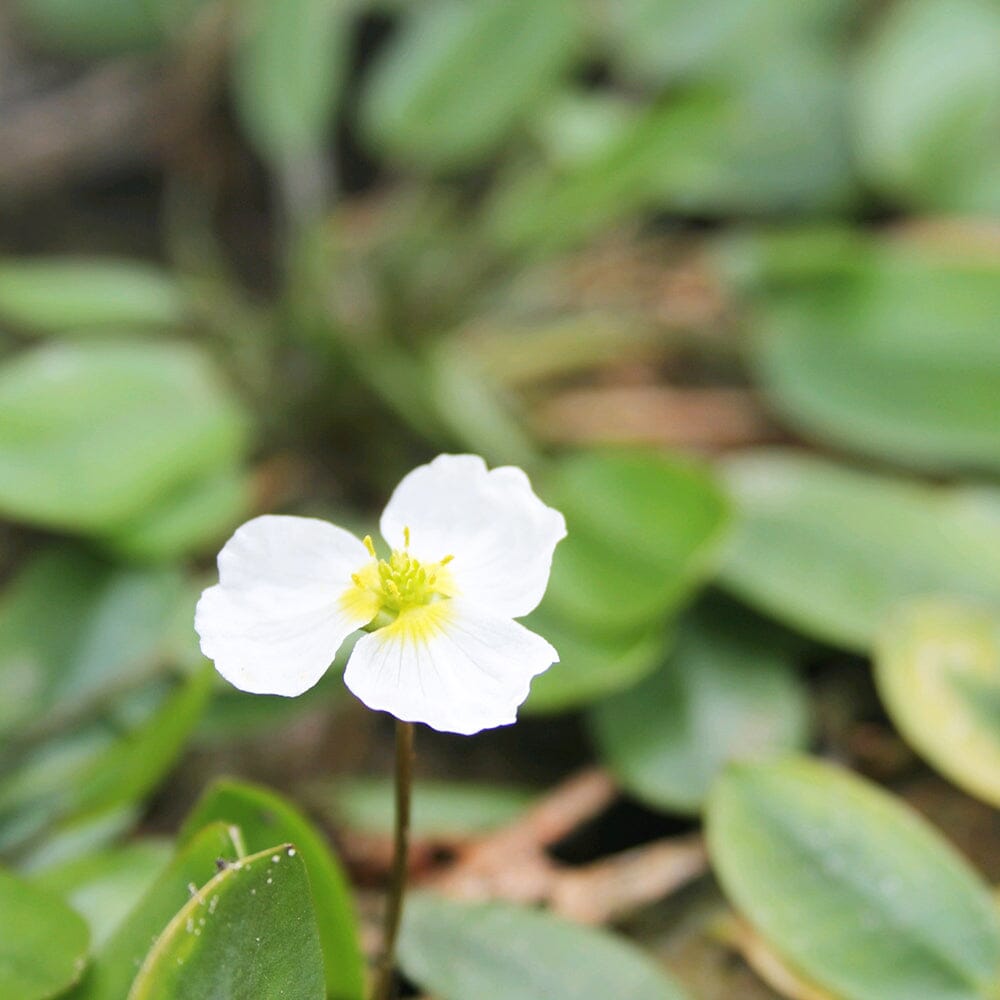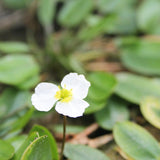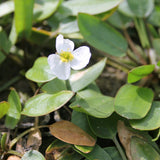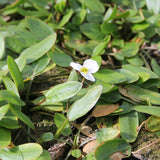Luronium Natans Aquatic Pond Plant
This unusual, rare plant has oval leaves that float on the water surface when grown in shallow water, but narrow long leaves in deeper areas where it can be grown up to 4m deep. It flowers prolifically when very shallow or on bare mud, with little white flowers and a yellow centre.
Luronium natans, commonly known as floating water-plantain, is a submerged aquatic plant native to Europe and parts of Asia. It typically grows in slow-moving or stagnant water bodies such as ponds, lakes, and marshes. Here is a general care guide for submerged aquatic plants that may be helpful:
Water and Light Requirements: Submerged aquatic plants like Luronium natans require clear, still water with ample sunlight. They thrive in full sun to partial shade. Make sure that the water has sufficient nutrients and is not heavily polluted.
Water Depth: Floating water-plantain is a fully submerged plant that grows in water depths of up to several feet. Ensure that the water is deep enough to accommodate the plant's growth without restricting its development.
Water Temperature: Luronium natans prefers cool to moderate water temperatures. It can tolerate a range of temperatures but generally does best in the 60-75°F (15-24°C) range. Extreme temperatures, both hot and cold, can stress or damage the plant.
Water Quality: The water quality should be good, with low levels of pollutants and high oxygen content. Regular water testing and maintenance, including water circulation and aeration, can help maintain suitable water conditions for the plant's health.
Planting: Submerged aquatic plants are typically planted in containers or baskets filled with aquatic soil or gravel. This helps to anchor the plant and provide nutrients. Ensure that the containers have drainage holes to prevent waterlogging. Gently place the plant in the container, covering the roots with the substrate, and then submerge the container in the desired location in the water.
Maintenance: Regular maintenance is essential for the health of submerged aquatic plants. This includes removing any dead or decaying plant material, controlling excessive algae growth, and periodically trimming the plant to maintain its desired size and shape. Be careful not to disturb the root system while performing these tasks.
Propagation: Luronium natans can propagate through seed production, but it can also spread by rhizome growth and division. If the plant becomes overcrowded, you can divide the rhizomes and replant them in suitable locations.
It's important to note that specific care requirements may vary based on the particular needs of Luronium natans as well as your local climate and growing conditions. If possible, consult with local horticulturists, aquatic plant specialists, or experienced gardeners who have knowledge about this particular plant to get more accurate care instructions and recommendations.
Selection:
Research different species of marginal pond plants to find ones that suit your pond's conditions and your aesthetic preferences. Consider factors such as height, flower colour, foliage texture, and seasonal interest when selecting plants.
Placement:
Observe the natural conditions of your pond, such as sun exposure, soil type, and water movement, and choose plants that are adapted to those conditions. Create different planting zones around the pond, with plants that prefer wet soil closer to the water's edge and those that tolerate drier soil further away.
Sunlight:
Marginal plants typically thrive in full sun to partial shade. Some species can tolerate more shade, but for optimal growth and flowering, provide them with at least 6 hours of direct sunlight per day.
Water Depth:
Determine the water depth requirements of the marginal plants you choose. Some plants prefer water up to 6 inches deep, while others can tolerate water up to 12 inches or more. Ensure that the water level remains consistent within the preferred range for the chosen plants.
Soil:
Marginal plants prefer a rich, loamy soil that retains moisture but is not waterlogged. Amend the soil with organic matter, such as compost or well-rotted manure, to improve its fertility and drainage. Avoid using heavy clay soil, as it can become compacted and restrict root growth.
Planting:
Dig a hole slightly larger than the root ball of the plant and loosen the soil at the bottom. Place the plant in the hole, ensuring that the crown is level with or slightly above the soil surface. Backfill the hole with soil and gently firm it around the plant to eliminate air pockets. Water thoroughly after planting to settle the soil and provide initial hydration.
Mulching:
Apply a layer of organic mulch around the base of the plants to suppress weeds, conserve moisture, and regulate soil temperature.Use materials like straw, shredded bark, or compost, and maintain a depth of 2-3 inches.
Watering:
Marginal plants prefer consistently moist soil but should not be waterlogged. Monitor the moisture level regularly and water as needed to keep the soil evenly moist. During hot and dry periods, provide supplemental watering to prevent the soil from drying out.
Fertilization:
Marginal plants generally do not require heavy fertilization if the soil is nutrient-rich. However, if growth appears weak or leaves show signs of nutrient deficiencies, apply a balanced slow-release fertilizer according to the manufacturer's instructions.
Maintenance:
Remove any yellowing or dead leaves to maintain plant health and appearance. Divide overcrowded plants every few years to prevent competition for resources and promote vigorous growth. Prune back excessive growth to maintain a tidy appearance and to prevent plants from encroaching on other plants or the pond itself.
Winter Care:
Hardy marginal plants can withstand winter temperatures and require minimal care. Cut back dead foliage in late fall or early spring to tidy up the planting area. In colder regions, consider protecting tender plants with a layer of mulch or covering them with burlap during winter to prevent frost damage.
Monitoring and Troubleshooting:
Regularly inspect plants for signs of pests, diseases, or nutrient deficiencies. Address any issues promptly with appropriate treatments, such as organic insecticides, fungicides, or nutrient amendments. By following these detailed tips and providing proper care, you can create a beautiful and thriving planting zone around your pond, enhancing its visual appeal and supporting a diverse ecosystem.


































